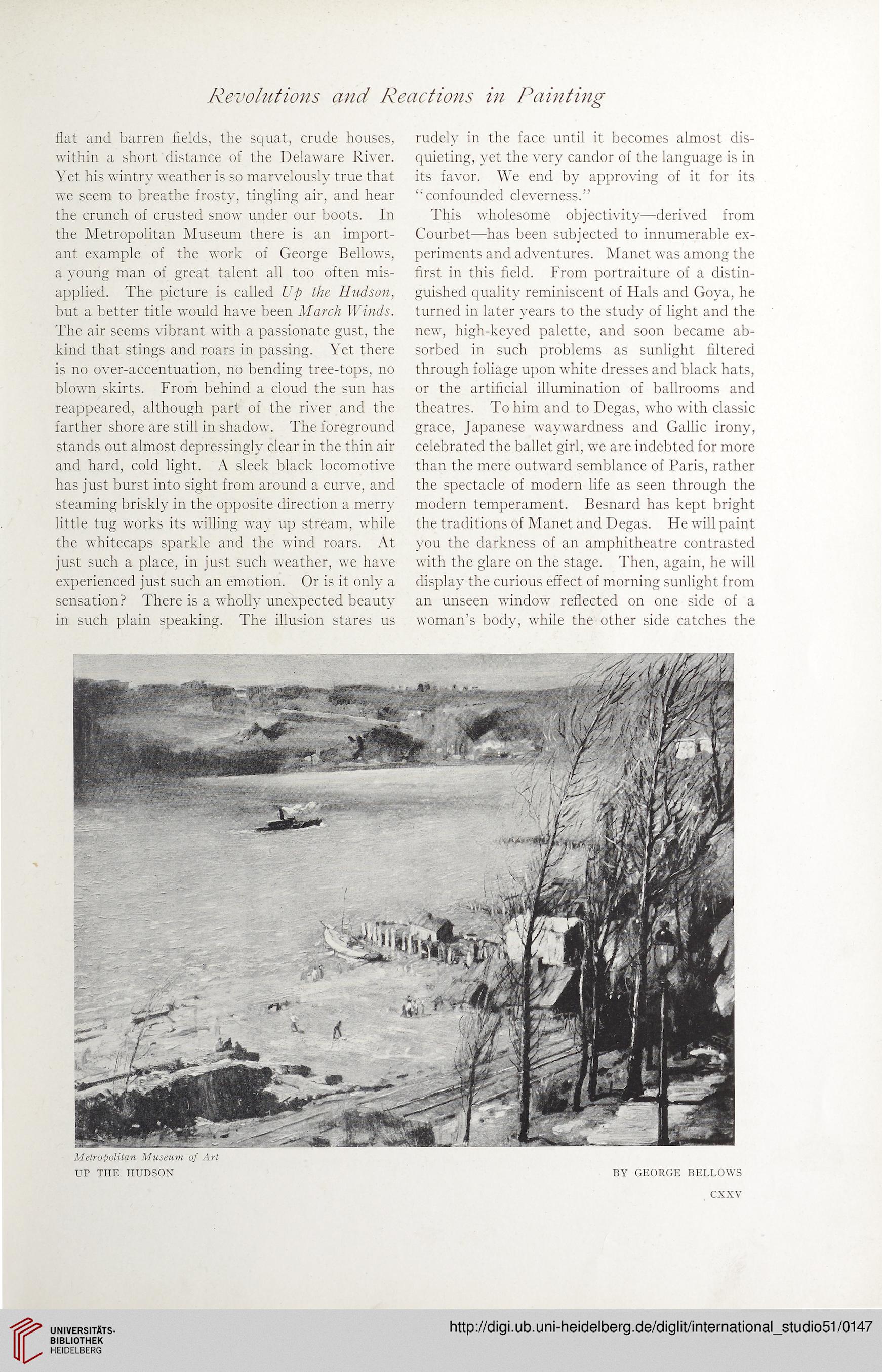Revolutions and Reactions in Painting
flat and barren fields, the squat, crude houses,
within a short distance of the Delaware River.
Yet his wintry weather is so marvelously true that
we seem to breathe frosty, tingling air, and hear
the crunch of crusted snow under our boots. In
the Metropolitan Museum there is an import-
ant example of the work of George Bellows,
a young man of great talent all too often mis-
applied. The picture is called Up the Hudson,
but a better title would have been March Winds.
The air seems vibrant with a passionate gust, the
kind that stings and roars in passing. Yet there
is no over-accentuation, no bending tree-tops, no
blown skirts. From behind a cloud the sun has
reappeared, although part of the river and the
farther shore are still in shadow. The foreground
stands out almost depressingly clear in the thin air
and hard, cold light. A sleek black locomotive
has just burst into sight from around a curve, and
steaming briskly in the opposite direction a merry
little tug works its willing way up stream, while
the whitecaps sparkle and the wind roars. At
just such a place, in just such weather, we have
experienced just such an emotion. Or is it only a
sensation? There is a wholly unexpected beauty
in such plain speaking. The illusion stares us
rudely in the face until it becomes almost dis-
quieting, yet the very candor of the language is in
its favor. We end by approving of it for its
“confounded cleverness.”
This wholesome objectivity—derived from
Courbet—has been subjected to innumerable ex-
periments and adventures. Manet was among the
first in this field. From portraiture of a distin-
guished quality reminiscent of Hals and Goya, he
turned in later years to the study of light and the
new, high-keyed palette, and soon became ab-
sorbed in such problems as sunlight filtered
through foliage upon white dresses and black hats,
or the artificial illumination of ballrooms and
theatres. To him and to Degas, who with classic
grace, Japanese waywardness and Gallic irony,
celebrated the ballet girl, we are indebted for more
than the mere outward semblance of Paris, rather
the spectacle of modern life as seen through the
modern temperament. Besnard has kept bright
the traditions of Manet and Degas. He will paint
you the darkness of an amphitheatre contrasted
with the glare on the stage. Then, again, he will
display the curious effect of morning sunlight from
an unseen window reflected on one side of a
woman’s body, while the other side catches the
Melro-politan Museum of Art
UP THE HUDSON BY GEORGE BELLOWS
CXXV
flat and barren fields, the squat, crude houses,
within a short distance of the Delaware River.
Yet his wintry weather is so marvelously true that
we seem to breathe frosty, tingling air, and hear
the crunch of crusted snow under our boots. In
the Metropolitan Museum there is an import-
ant example of the work of George Bellows,
a young man of great talent all too often mis-
applied. The picture is called Up the Hudson,
but a better title would have been March Winds.
The air seems vibrant with a passionate gust, the
kind that stings and roars in passing. Yet there
is no over-accentuation, no bending tree-tops, no
blown skirts. From behind a cloud the sun has
reappeared, although part of the river and the
farther shore are still in shadow. The foreground
stands out almost depressingly clear in the thin air
and hard, cold light. A sleek black locomotive
has just burst into sight from around a curve, and
steaming briskly in the opposite direction a merry
little tug works its willing way up stream, while
the whitecaps sparkle and the wind roars. At
just such a place, in just such weather, we have
experienced just such an emotion. Or is it only a
sensation? There is a wholly unexpected beauty
in such plain speaking. The illusion stares us
rudely in the face until it becomes almost dis-
quieting, yet the very candor of the language is in
its favor. We end by approving of it for its
“confounded cleverness.”
This wholesome objectivity—derived from
Courbet—has been subjected to innumerable ex-
periments and adventures. Manet was among the
first in this field. From portraiture of a distin-
guished quality reminiscent of Hals and Goya, he
turned in later years to the study of light and the
new, high-keyed palette, and soon became ab-
sorbed in such problems as sunlight filtered
through foliage upon white dresses and black hats,
or the artificial illumination of ballrooms and
theatres. To him and to Degas, who with classic
grace, Japanese waywardness and Gallic irony,
celebrated the ballet girl, we are indebted for more
than the mere outward semblance of Paris, rather
the spectacle of modern life as seen through the
modern temperament. Besnard has kept bright
the traditions of Manet and Degas. He will paint
you the darkness of an amphitheatre contrasted
with the glare on the stage. Then, again, he will
display the curious effect of morning sunlight from
an unseen window reflected on one side of a
woman’s body, while the other side catches the
Melro-politan Museum of Art
UP THE HUDSON BY GEORGE BELLOWS
CXXV




